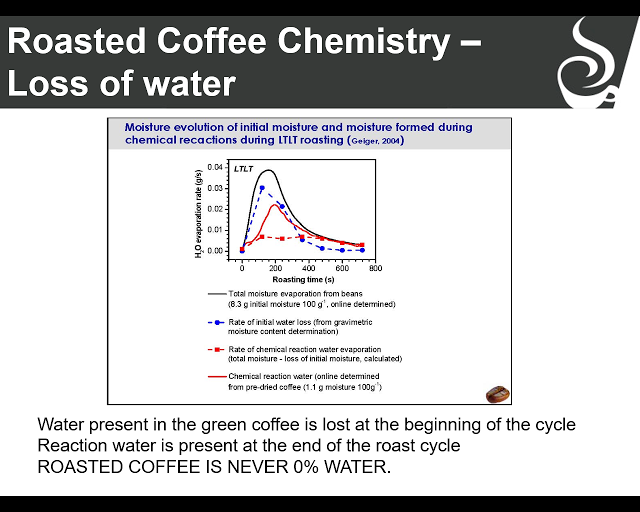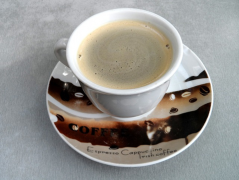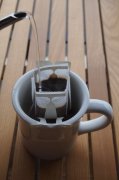Professional coffee roasting | Analysis of water evapotranspiration during coffee roasting
For professional baristas, please follow the coffee workshop (Wechat official account cafe_style)
Spend a little space to supplement the discussion about the degree of evaporation of water during baking at the Atti bug last night.
The following figure shows the water evapotranspiration ratio distribution measured by a 12-minute (720s) baking (LTLT: Low Temperature Long Time slow baking for a long time, it can be assumed to be using 230C hot air).

Source: www.probatburns.com
The black solid line is a raw bean with a moisture content of 8.3%. According to the evapotranspiration ratio (g / s) of total water (free water plus chemical reaction) measured by baking time, we find that the highest evapotranspiration ratio is from 40 seconds to 280 seconds at the beginning of baking. the water evapotranspiration per second is more than 0.02 g / s, and after 400 seconds, the evapotranspiration per second falls below 0.01 g / s. It means that there is not much water in the beans, as emphasized in the text below, Roasted coffee is never 0% water (the moisture content of roasted coffee is never 0%).
The blue dotted line measures the evapotranspiration ratio of the initial water content of raw beans (excluding water generated by chemical reactions), and its trend is the same as the total water evapotranspiration ratio.
The red dotted line measures the evapotranspiration ratio of the water produced by the chemical reaction, which is equivalent to the difference between the total water evapotranspiration and the initial water evapotranspiration, showing a stable state of loss (about 0.006 g / s). That is, the evapotranspiration rate of chemical reaction water is about the same at the beginning of baking or at the end of baking.
The red solid line is pre-dried to a raw bean with a moisture content of only 1.1%. During the baking process of 720 seconds, we found that although it was very dry, as long as it was heated for 80 seconds, its reaction water evapotranspiration reached the ratio of ordinary raw beans, and reached the peak of 0.022 g in 200s, and then quickly dropped to overlap with the reaction water evaporation ratio of ordinary raw beans. After pre-dried beans, the chemical reaction water is produced and evaporated much more during baking, which is an interesting phenomenon, which may be used as a reference for secondary baking techniques.
In addition, according to experience, using hands to feel or actually measure the humidity in the exhaust pipe, we find that the highest humidity is in the stage of explosion, which seems to be different from the measurement in the picture above. I guess, when the beans burst, the volatile gases produced by water vapor and organic matter burst instantly, resulting in a relatively high humidity in the exhaust space at that time. It is different from the basis of using small batch hot air baking to collect and analyze the water evapotranspiration of beans, so the conclusions are different, but in terms of the whole roasting process of coffee beans, there is no doubt that the first stage (dehydration stage) is the stage with the most moisture loss.
In fact, the literature I quoted earlier is this picture. In addition to LTLT, there is also a case of water evapotranspiration in 180 seconds of HTST (bottom left). It can be found that high temperature and fast baking beans leave more water (the total evapotranspiration at the end is still 0.065 g / s).

Important Notice :
前街咖啡 FrontStreet Coffee has moved to new addredd:
FrontStreet Coffee Address: 315,Donghua East Road,GuangZhou
Tel:020 38364473
- Prev

Drinking coffee depends on personality? Coffee personality introduction ~ come and see what kind of coffee personality you are!
Communication of professional baristas Please follow the coffee workshop (official Wechat account cafe_style) A person's personality can be easily seen by drinking coffee. Can you believe it? Today, the editor is going to share the coffee personality introduction with you! Want to know what kind of coffee goes with what kind of personality? Come and see if your favorite coffee matches your personality. Coffee personality introduction 1: black
- Next

[hanging-ear coffee brewing skill teaching] A talented person teaches you how to make a good cup of hanging-ear coffee.
Professional barista communication Please pay attention to the coffee workshop (Wechat official account cafe_style) nowadays many people buy strained coffee to brew because they do not have coffee utensils and want to drink strong coffee close to the original taste, but do you know that strained coffee also has brewing skills? A delicious cup of coffee is also related to its coffee brewing skills. I want to brew a good cup of coffee.
Related
- Beginners will see the "Coffee pull flower" guide!
- What is the difference between ice blog purified milk and ordinary milk coffee?
- Why is the Philippines the largest producer of crops in Liberia?
- For coffee extraction, should the fine powder be retained?
- How does extracted espresso fill pressed powder? How much strength does it take to press the powder?
- How to make jasmine cold extract coffee? Is the jasmine + latte good?
- Will this little toy really make the coffee taste better? How does Lily Drip affect coffee extraction?
- Will the action of slapping the filter cup also affect coffee extraction?
- What's the difference between powder-to-water ratio and powder-to-liquid ratio?
- What is the Ethiopian local species? What does it have to do with Heirloom native species?

